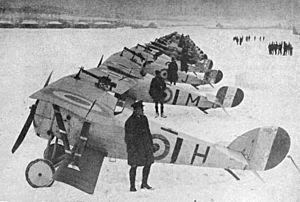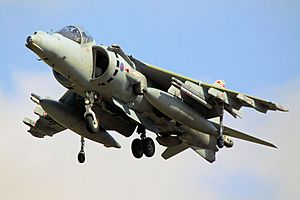No. 1 Squadron RAF facts for kids
Quick facts for kids No. 1 (F) Squadron RAF |
|
|---|---|
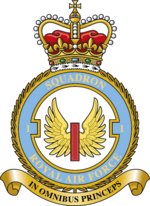
Squadron badge
|
|
| Active | 1 April 1911 – 13 May 1912 (RE) 13 May 1912 – 1 April 1918 (RFC) 1 April 1918 – 20 January 1920 (RAF) 21 January 1920 – 1 November 1926 1 February 1927 – 23 June 1958 1 July 1958 – 28 January 2011 15 September 2012 – present |
| Country | United Kingdom |
| Branch | Royal Air Force |
| Type | Flying squadron |
| Role | Multi–role combat |
| Part of | No. 1 Group RAF |
| Home station | RAF Lossiemouth |
| Motto(s) | In omnibus princeps (Latin for 'First in all things') |
| Aircraft | Eurofighter Typhoon FGR4 |
| Battle honours |
|
| Insignia | |
| Squadron tail badge | 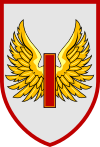 |
| Squadron badge heraldry | A winged numeral "1". Approved by King Edward VIII in July 1936 as the authorised version of a badge which had originated during the First World War. |
| Post 1950 squadron roundel | |
| Squadron Codes | NA (Nov 1938 – Sep 1939) JX (Sep 1939 – Apr 1951) FA–FZ (Present) |
No. 1 Squadron, also known as No. 1 (Fighter) Squadron, is a special group of pilots and aircraft in the Royal Air Force (RAF). It was the first squadron ever to fly a VTOL aircraft, which can take off and land vertically like a helicopter. Today, they fly powerful Eurofighter Typhoon jets from RAF Lossiemouth in Scotland.
The squadron's motto is In omnibus princeps, which means "First in all things." This motto shows how important the squadron is. It's the oldest unit in the RAF and has been part of almost every major British military operation. This includes big events like the First World War, Second World War, Falklands War, and conflicts in Iraq and Afghanistan.
Contents
A Brief History of No. 1 Squadron
Early Days: Balloons to Biplanes (1878–1918)
No. 1 Squadron started a very long time ago, in 1878. Back then, it was called the No. 1 Balloon Company. They used balloons for observation, like looking over battlefields.
On 1 April 1911, this group became part of the new Air Battalion Royal Engineers. They were in charge of flying lighter-than-air aircraft, mostly balloons and kites.
A year later, on 13 May 1912, the Royal Flying Corps (RFC) was created. No. 1 Company became No. 1 Squadron, Royal Flying Corps. It was one of the very first squadrons in the RFC. At first, they still used airships and kites. But in 1913, all the airships were moved to the Navy. No. 1 Squadron then became a support unit for the British army in France.
In August 1914, the squadron changed again. It became an aircraft squadron, flying planes like the Avro 504 and Royal Aircraft Factory B.E.8. They flew to France in March 1915. Their main job was to fly reconnaissance missions, which means scouting and gathering information. They also had a few fighter planes to protect themselves.
The squadron quickly joined the action, taking part in battles like the Battle of Neuve Chapelle. They often flew reconnaissance during big battles like the Second Battle of Ypres. By 1917, No. 1 Squadron became a full-time fighter squadron. They flew fast planes like the Nieuport 17 and Nieuport 27.
In January 1918, they got even better planes, the S.E.5as. When the Royal Air Force (RAF) was formed on 1 April 1918, No. 1 Squadron kept its name. Many brave pilots, known as flying aces, served in No. 1 Squadron during this time. They shot down many enemy aircraft.
Between the World Wars (1919–1939)
After the First World War, the squadron returned to the UK and was briefly disbanded. But it reformed in India in 1920, flying Sopwith Snipe planes. They later moved to Iraq to help with policing duties, flying missions against local tribal forces.
In 1927, No. 1 Squadron reformed in England as a Home Defence Fighter Squadron. They flew Armstrong Whitworth Siskins and later the Hawker Fury Mk.1. The squadron became famous for its amazing aerobatic displays. They performed across the UK and even in Switzerland. However, it became clear that their planes were not as advanced as new German aircraft like the Messerschmitt Bf 109. In October 1938, they received the modern Hawker Hurricane Mk.I.
World War II: Defending Britain (1939–1945)
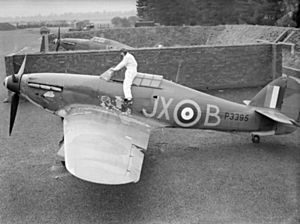
When the Second World War began in September 1939, No. 1 Squadron went to France. They flew over enemy territory and soon shot down their first enemy plane, a Dornier Do 17. When the Battle of France started in May 1940, the squadron had to retreat many times. They finally left France on 18 June and returned to England.
In August 1940, the squadron joined the Battle of Britain. This was a huge air battle where the RAF defended the UK from German attacks. No. 1 Squadron was heavily involved until September, when they moved to RAF Wittering to rest and get new planes.
In 1941, they started flying "Rhubarb" missions, which were low-level attacks over enemy territory. They also flew night missions. One of their pilots, Karel Kuttelwascher, became the RAF's top night intruder pilot.
In July 1942, they got new Hawker Typhoon fighter-bombers and switched back to daytime operations. In April 1944, they received Supermarine Spitfire Mk.IX planes. They helped shoot down 39 V1 flying bombs, which were unmanned rockets launched by Germany. They also supported ground troops during the Normandy landings and other battles.
Post-War and the Harrier Era (1946–2011)
After the war, in 1946, No. 1 Squadron became one of the first RAF squadrons to fly jet aircraft, the Gloster Meteor. They later flew Hawker Hunter jets during the 1956 Suez Crisis. The squadron was briefly disbanded in 1958 but reformed shortly after.
In 1969, No. 1 Squadron made history again. They became the world's first squadron to operate a V/STOL aircraft, the Hawker Siddeley Harrier. This amazing jet could take off and land vertically, like a helicopter, but fly as fast as a regular jet.
During the Falklands War in 1982, a part of No. 1 Squadron was sent to the South Atlantic. They flew Harrier jets from the aircraft carrier HMS Hermes, attacking Argentine forces. They later upgraded to newer Harrier IIs. The squadron also flew missions during the Bosnian War and the Kosovo War.
No. 1 Squadron moved to RAF Cottesmore in 2000. They continued to fly Harriers and took part in the Iraq War in 2003. They also played a role in the War in Afghanistan.
However, in 2010, the British government decided to retire all Harriers. No. 1 Squadron stopped flying Harriers in December 2010 and was formally disbanded in January 2011.
The Typhoon Era (2012–Present)
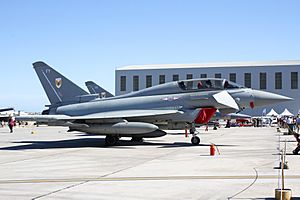
But No. 1 Squadron didn't stay gone for long! On 15 September 2012, it reformed at RAF Leuchars. This time, they started flying the advanced Eurofighter Typhoon jet.
Since then, the squadron has taken part in many international training exercises. This includes Exercise Shaheen Star in the United Arab Emirates and Exercise Bersama Shield in Malaysia.
On 8 September 2014, No. 1 (F) Squadron moved to its current home, RAF Lossiemouth. They work alongside other RAF squadrons there. In November 2019, the squadron sent four Typhoon jets and 100 personnel to Iceland to help with NATO air policing.
Aircraft Operated by No. 1 Squadron
No. 1 Squadron has flown many different types of aircraft throughout its long history:
- Avro 504 (1915–1916)
- B.E.8 (1915–1916)
- Morane Parasol (1915–1916)
- Nieuport 17 (1916–1917)
- Nieuport 27 (1917–1918)
- SE5a (1918–1920)
- Sopwith Snipe (1920–1927)
- Armstrong Whitworth Siskin (1927–1933)
- Hawker Fury (1933–1937)
- Hawker Hurricane (1937–1943)
- Hawker Typhoon (1943–1944)
- Supermarine Spitfire (1944–1950)
- Gloster Meteor F.8 (1950–1957)
- Hawker Hunter F.5/F.6/FGA.9/T.7 (1957–1970)
- Hawker Siddeley Harrier GR.1 and GR.3 (1969–1989)
- British Aerospace Harrier GR5, GR7 and GR9 (1988–2010)
- Eurofighter Typhoon FGR4 (2012 – present)
Battle Honours
Battle honours are special awards given to military units for their bravery and success in battles. Here are the battle honours awarded to No. 1 Squadron:
- Western Front 1915–1918
- Ypres 1915
- Neuve Chapelle
- Loos
- Somme 1916
- Arras
- Ypres 1917
- Lys
- Amiens
- Somme 1918
- Hindenburg Line
- Independent Force and Germany 1918
- Kurdistan 1922–1925
- Iraq 1923–1925
- France and Low Countries 1939–1940
- Battle of Britain 1940
- Channel and North Sea 1941–1945
- Home Defence 1940–1945
- Fortress Europe 1941–1944
- Arnhem
- Normandy 1944
- France and Germany 1944–1945
- Biscay 1944–1945
- Rhine
- South Atlantic 1982
- Kosovo
- Iraq 2003
Items in bold can be proudly shown on the squadron's official flag.
Images for kids
-
Men of the Royal Flying Corps beside an Avro 504.
-
A Royal Flying Corps Nieuport 23 in 1917.
-
S.E.5a fighters and pilots of No. 1 Squadron at Clairmarais aerodrome, July 1918.
-
Hawker Hurricane Mk I, N2358 Z, of No. 1 Squadron is refuelled while undergoing an engine check at Vassincourt, France, during 1940.
-
Hawker Typhoon IB R8752 of No. 1 Squadron, written-off after crash-landing in a field near its base at Lympne on 2 June 1943.
-
A Hawker Hunter T7 in No. 1 Squadron markings during the late 1950s.


